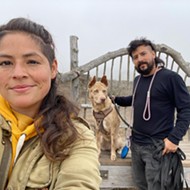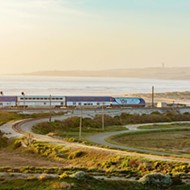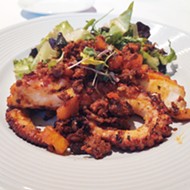Amazon Marketplace offers fine wines
Their virtual wine shelves can pay off for Central Coast wineries
By Kathy Marcks Hardesty[{
"name": "Ad - Medium Rectangle CC01 - 300x250",
"id": "AdMediumRectangleCC01300x250",
"class": "inlineCenter",
"insertPoint": "8",
"component": "2963441",
"requiredCountToDisplay": "12"
},{
"name": "Ad - Medium Rectangle LC01 - 300x250",
"id": "AdMediumRectangleCC01300x250",
"class": "inlineCenter",
"insertPoint": "18",
"component": "2963441",
"requiredCountToDisplay": "22"
},{
"name": "Ad - Medium Rectangle LC09 - 300x250",
"id": "AdMediumRectangleLC09300x250",
"class": "inlineCenter",
"insertPoint": "28",
"component": "3252660",
"requiredCountToDisplay": "32"
}]
Any time I’m shopping online, I’m searching for value pricing, and that always leads to the world’s largest virtual retailer: Amazon. It immediately pops into mind for comparing prices on electronics or beauty products, but for buying wine? Frankly I never gave it a thought. That should hardly be surprising since San Luis Obispoans live in the heart of the most rapidly growing and exciting wine region in the United States. We can pick up great Central Coast wines in wine shops from Santa Cruz to Santa Barbara. We can get value prices on local, albeit limited wines at Costco and Trader Joe’s. And we wine lovers relish the luxury of being able to taste and buy directly from our excellent neighborhood tasting rooms.
Like most oenophiles, I appreciate fine wines from all over the globe. But I rarely find my favorite German Rieslings or extremely-limited New Zealand gems at local retailers like I do in San Francisco wine shops. That alone would motivate me to order international wines in Amazon’s virtual wine shop. But last week I learned many interesting new facts about the Amazon Marketplace during WiVi, a wine industry symposium and trade show in Paso Robles. Amazon Marketplace only sells domestic wines, which means strictly wines produced in the United States. Their success in the states may create the opportunity to buy international wines, but knowing the complex regulations involving the wine trade, it’s unlikely to happen soon.
After seeing an array of good Central Coast wines on Amazon Marketplace—Castoro, Domaine Degher, Eberle, Peachy Canyon, Saucelito Canyon, and Stephen Ross—I called on several vintners. When asked about their experience with virtual sales, they all admitted it’s helpful but not quite what they expected.
Amazon has done business for 15 years, but only started selling wine five months ago. When it opened the virtual wine market on Nov. 7, 2012, it started with an impressive 1,000 wines to sell in 15 states, including Washington, D.C.
The WiVi morning session opened with an introduction to Amazon Marketplace Vice President and General Manager Peter Faricy. I attended it before interviewing him personally later that morning. Faricy pointed out that the Amazon Marketplace has two million sellers around the world in 10 countries. Potentially that could mean millions of customers viewing wines on the virtual shelf space, as he described it.
“We’re constantly trying to improve the selection on Amazon Marketplace,” he explained. “People want a rich experience online: They want to know more about the winemaker, the brand, and see the bottle. We provide a great opportunity for wineries to reach consumers.”
It’s obvious the wineries are taking small first steps; none appears to be selling all of its wines in the marketplace yet. But Amazon is trying to encourage wineries to add all of their wines since they don’t pay unless they’re sold. It’s also asking wineries to send one bottle of each wine to photograph. Based on the number of bottle shots missing on the pages, not everyone is doing it.
When consumers order wine online, they pay Amazon, and Amazon pays the winery, the seller of record. The winery ships the orders following Amazon standards—one bottle or six bottles for a flat fee of $9.99, or a case for $19.98. Returns are handled by the winery. One Central Coast winery sold six bottles in one order, but orders are typically one to three bottles.
“I’ve been with them since Nov. 7 and had some sales, but it hasn’t been that great,” winemaker Denis Degher, owner of Domaine Degher in Paso Robles, candidly admitted. “The promotional aspect has been beneficial. It brought me some direct sales through my website, so the exposure is pretty good.”
For the trade attendees, Faricy noted: “We want every winery to have a chance to join Amazon Marketplace to offer a wider variety. We have a thousand wines available now and room for thousands more.”
Faricy spent his last four years with Amazon in this role on Amazon Marketplace. Amazon attempted selling wine a few years ago, but since it didn’t take off, it’s easy to imagine the complex project required more planning.
“Amazon does provide a great opportunity for wineries to reach consumers,” he said.
Amazon lets wineries take charge of their pages, which allows them to post photos or videos.
“We provide an economic platform for wineries and provide payment services and fraud protection,” Faricy said. “We have a history of customer care, and we think of the wineries as our customers.”
It’s a good time for wineries to start with Amazon, since it’s committed to waiving additional charges through 2013. Currently wineries only pay Amazon once they’ve sold wine in the virtual market, a 15 percent referral fee (Amazon’s term). That’s low compared to the higher fees wineries pay wine distributers, but there are additional costs for the wineries including all that’s involved in shipping.
I learned from some vintners (their brands will remain anonymous) that when they joined Amazon Marketplace they were informed the retailer would eventually begin charging a “cooperative fee” of $49 for every $350 in sales and a monthly subscription fee of $39.99. Both charges had been waived until March. Amazon sent a new e-mail to the wineries, dated March 19—the day before the trade show—noting it had good news to share: “Amazon will continue to waive both the Cooperative and Monthly Subscription fees for wineries through the end of 2013.” During the interview, Faricy said the wineries paid no additional fees other than the 15 percent referral fee. However, wineries should be aware that policy may change in the future.
“We have a long-term view of being committed to customers, and all of our customers appreciate value. We treat wineries as customers and dedicate a lot of resources to make it easy for them,” Faricy explained.
One vintner confirmed that Amazon is user friendly and provides excellent customer service.
“I was surprised and thought it was amazingly easy once they sent the template to me. I was afraid it would be onerous,” said vintner Paula Dooley, who, along with her husband Stephen Ross Dooley, owns Stephen Ross in SLO. They supplied three pinot noirs (which weren’t returned) to Amazon for taking photos, and saw some sales.
“I don’t mind paying a percentage of sales, but I’m not paying additional fees like a monthly subscription when the winery does all the work,” Dooley said. “Overall, it’s been a positive experience in a small way for Stephen Ross.” ∆
Contact Cuisine columnist Kathy Marcks Hardesty at [email protected].










